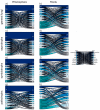Early stage root-Associated fungi show a high temporal turnover, but Are independent of beech progeny
- PMID: 32033191
- PMCID: PMC7074820
- DOI: 10.3390/microorganisms8020210
Early stage root-Associated fungi show a high temporal turnover, but Are independent of beech progeny
Abstract
The relationship between trees and root-associated fungal communities is complex. By specific root deposits and other signal cues, different tree species are able to attract divergent sets of fungal species. Plant intraspecific differences can lead to variable fungal patterns in the root's proximity. Therefore, within the Beech Transplant Experiment, we analyzed the impact of three different European beech ecotypes on the fungal communities in roots and the surrounding rhizosphere soil at two time points. Beech nuts were collected in three German sites in 2011. After one year, seedlings of the different progenies were out-planted on one site and eventually re-sampled in 2014 and 2017. We applied high-throughput sequencing of the fungal ITS2 to determine the correlation between tree progeny, a possible home-field advantage, plant development and root-associated fungal guilds under field conditions. Our result showed no effect of beech progeny on either fungal OTU richness or fungal community structure. However, over time the fungal OTU richness in roots increased and the fungal communities changed significantly, also in rhizosphere. In both plant compartments, the fungal communities displayed a high temporal turnover, indicating a permanent development and functional adaption of the root mycobiome of young beeches.
Keywords: Beech Transplant Experiment; Biodiversity Exploratories; Fagus sylvatica; Illumina sequencing; fungal ITS2; rhizosphere.
Conflict of interest statement
The authors declare no conflict of interest.
Figures




Similar articles
-
Partner turnover and changes in ectomycorrhizal fungal communities during the early life stages of European beech (Fagus sylvatica L.).Mycorrhiza. 2021 Jan;31(1):43-53. doi: 10.1007/s00572-020-00998-0. Epub 2020 Nov 2. Mycorrhiza. 2021. PMID: 33140217
-
Contrasting Patterns of Functional Diversity in Coffee Root Fungal Communities Associated with Organic and Conventionally Managed Fields.Appl Environ Microbiol. 2020 May 19;86(11):e00052-20. doi: 10.1128/AEM.00052-20. Print 2020 May 19. Appl Environ Microbiol. 2020. PMID: 32220838 Free PMC article.
-
[Research on relationship between occurrence of root rot and changes of fungal communities in rhizosphere of Panax quinquefolius].Zhongguo Zhong Yao Za Zhi. 2018 May;43(10):2038-2047. doi: 10.19540/j.cnki.cjcmm.20180307.006. Zhongguo Zhong Yao Za Zhi. 2018. PMID: 29933668 Chinese.
-
Specific impacts of beech and Norway spruce on the structure and diversity of the rhizosphere and soil microbial communities.Sci Rep. 2016 Jun 15;6:27756. doi: 10.1038/srep27756. Sci Rep. 2016. PMID: 27302652 Free PMC article.
-
Diversity and Composition of the Leaf Mycobiome of Beech (Fagus sylvatica) Are Affected by Local Habitat Conditions and Leaf Biochemistry.PLoS One. 2016 Apr 14;11(4):e0152878. doi: 10.1371/journal.pone.0152878. eCollection 2016. PLoS One. 2016. PMID: 27078859 Free PMC article.
Cited by
-
Tree Root Zone Microbiome: Exploring the Magnitude of Environmental Conditions and Host Tree Impact.Front Microbiol. 2020 Apr 23;11:749. doi: 10.3389/fmicb.2020.00749. eCollection 2020. Front Microbiol. 2020. PMID: 32390986 Free PMC article.
References
-
- Pereira e Silva M.C., Semenov A.V., Schmitt H., van Elsas J.D., Salles J.F. Microbe-mediated processes as indicators to establish the normal operating range of soil functioning. Soil Biol. Biochem. 2013;57:995–1002. doi: 10.1016/j.soilbio.2012.10.002. - DOI
Grants and funding
LinkOut - more resources
Full Text Sources

